Last Friday, 4/21/06, I attended “The New Downtowns: A Conference on the Future of Urban Centers,” sponsored by the Policy Institute for the Region at Princeton University. While the panels focused on Lower Manhattan and Philadelphia—and to a lesser extent Newark and other New Jersey cities—it was striking how, viewed through a Brooklyn-centric lens, the Atlantic Yards project seems out of place in the discussion of lessons learned and best practices.
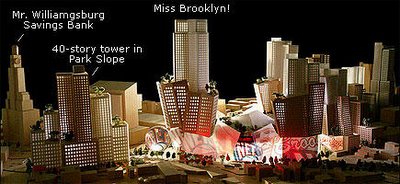 While the mostly-residential Atlantic Yards has been promoted by the developer as an economic development engine (because of the dubious theory of increased income tax revenues), the development of residential over commercial space was hardly heralded in the same manner. (Graphic of earlier version of plan from 7/5/05 New York Times, with addenda by NoLandGrab.org.)
While the mostly-residential Atlantic Yards has been promoted by the developer as an economic development engine (because of the dubious theory of increased income tax revenues), the development of residential over commercial space was hardly heralded in the same manner. (Graphic of earlier version of plan from 7/5/05 New York Times, with addenda by NoLandGrab.org.)
While there was no planning for the Atlantic Yards site and there has been little public process, panelists cited the value of neutral planners and the importance of public participation.
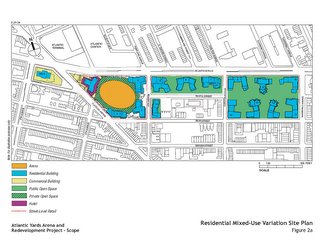 While Atlantic Yards would be a single-source project announced as a fait accompli, panelists stressed the importance of a level playing field and an open competition for sites.
While Atlantic Yards would be a single-source project announced as a fait accompli, panelists stressed the importance of a level playing field and an open competition for sites.
While Atlantic Yards would close streets to create a superblock and otherwise violate some precepts advocated by urbanist Jane Jacobs (RIP), a panelist from the Bloomberg administration presented Jacobs’s insights as enduringly valuable. (Indeed, there was no example in the panels of a major rezoning--or in the case of Atlantic Yards, a state override of city zoning--to stimulate a much more dense development.)
Live. Work? Play.
First, Downtown Brooklyn—and Forest City Ratner's proposed extension via the Atlantic Yards project—may not qualify as a “new downtown,” because its development, as of now, is skewed toward residential space. Moreover, part of the proposed footprint is a long-neglected segment of an "old" redevelopment effort, the 1960s-era Atlantic Terminal Urban Renewal Area (ATURA).
 A “new downtown,” according to a definition presented by Eugenie Birch, of the Penn Institute for Urban Research of the University of Pennsylvania, is a central business district and its surrounds that has experienced reinvention as a well-populated, mixed-use center suitable for living, working, and playing. It has low vacancy rates and high usage of its infrastructure and amenities. Its tax revenues soar and its household growth rates surpass its city’s. It is an icon of urban resilience and renaissance. Its reach extends beyond the traditional central business district into nearby neighborhoods… [It] has new residential, entertainment, cultural, and recreational activities and has refashioned its retail and office employment.
A “new downtown,” according to a definition presented by Eugenie Birch, of the Penn Institute for Urban Research of the University of Pennsylvania, is a central business district and its surrounds that has experienced reinvention as a well-populated, mixed-use center suitable for living, working, and playing. It has low vacancy rates and high usage of its infrastructure and amenities. Its tax revenues soar and its household growth rates surpass its city’s. It is an icon of urban resilience and renaissance. Its reach extends beyond the traditional central business district into nearby neighborhoods… [It] has new residential, entertainment, cultural, and recreational activities and has refashioned its retail and office employment.
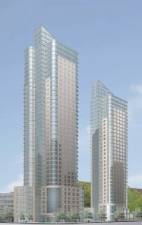 This would apply only partly to Brooklyn. Notably, even though Downtown Brooklyn has been rezoned to accommodate new office construction, developers have been building residential towers rather than office space. In planning to turn Prospect Heights into Downtown Brooklyn with the Atlantic Yards project, Forest City Ratner originally promoted a mix of residential, office, and recreational uses. Though the “Live. Work. Play.” slogan was promoted heavily by FCR in the early stages of public discussion, the new AtlanticYards.com web site drops that formulation, likely because FCR recognizes that it’s hard to promote “Work” when the number of promised office jobs has been slashed from 10,000 to 2500. (Graphic is of new projects at Gold Street.)
This would apply only partly to Brooklyn. Notably, even though Downtown Brooklyn has been rezoned to accommodate new office construction, developers have been building residential towers rather than office space. In planning to turn Prospect Heights into Downtown Brooklyn with the Atlantic Yards project, Forest City Ratner originally promoted a mix of residential, office, and recreational uses. Though the “Live. Work. Play.” slogan was promoted heavily by FCR in the early stages of public discussion, the new AtlanticYards.com web site drops that formulation, likely because FCR recognizes that it’s hard to promote “Work” when the number of promised office jobs has been slashed from 10,000 to 2500. (Graphic is of new projects at Gold Street.)
Panelist Paul Levy, president and CEO, Philadelphia Center City District, noted that 60 percent of downtown Philadelphia residents work downtown, and 37 percent walk to work. “We are reclaiming people who live in the suburbs,” he said, adding that new residents also cited the ability to walk to arts facilities and other amenities. In Brooklyn, most of those moving downtown or to the Atlantic Yards project likely would take the subway to Manhattan for work.
Elizabeth Strom, a geography professor at the University of South Florida, observed that, for generations, urban density was determined by constraints caused by transportation, communication, technology, and safety. After the decline of downtowns, and the departure of former mainstays like banks, insurance companies, and department stores, the new downtown was coaxed by public and philanthropic dollars, not the market.
Now downtown development corporations are dominated by real estate concerns, along with can’t-leave-the-city institutions in health care and higher education. The “new downtown,” Strom observed, is about culture, entertainment, restaurants, and residences. “It’s just not economically important the way it used to be.”
Why the new Downtown?
Economist Richard Voith, VP of Philadelphia-based Econsult Corporation, and a panel of respondents offered several reasons for the decline of downtown, and its revival. (Voith's paper is here.) Suburbanization and the automobile fueled the post-war decline of central cities. Burdened by higher social and service costs, faced with a lack of federal investment, cities lost power regionally and nationally. Cities became notorious for crime and underperforming schools. Beyond that, telecommunication advances were thought to have eliminated the need for face to face contacts.
However, downtowns bounced back in the 1980s. Post-college youth always move to cities and, because they got married and had kids later, were more likely to stay. Baby boomers downsized from the suburbs and moved back for urban amenities. Costs in the suburbs increased, and many recognized the implicit costs of commuting times. Cities made changes, such as offering tax incentives and creating Business Improvement Districts (BIDs) to foster residential construction and amenities. New mayors focused on fighting crime and improving schools.
Observed Levy: “I don’t think we’re restoring the CBD [Central Business District] of 1910 but the downtown of 1850 that was a live-work environment, that has never ceased to exist in Europe.” The residential use was squeezed out in the 1890s, as cities boomed, but the transit network makes urban life attractive.
Levy noted that deliberate federal policies undermined cities. “From 1934 to 1968, every American city was redlined by the FHA [Federal Housing Administration],” he said, adding that gas price subsidies and highway spending also fostered suburbanization. “Maybe we can consider the investments in downtowns as reparations payments.”
Jobs crucial
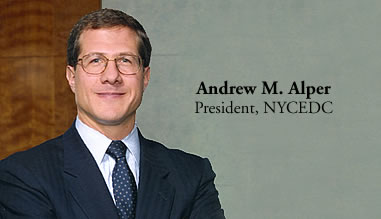 “We have to remember that the downtown holds jobs,” Birch said. “Downtown jobs are extremely important for supporting the neighborhoods.” And the questions was also addressed by Andrew Alper, president of the New York City Economic Development Corporation (right), the keynote speaker at lunch.
“We have to remember that the downtown holds jobs,” Birch said. “Downtown jobs are extremely important for supporting the neighborhoods.” And the questions was also addressed by Andrew Alper, president of the New York City Economic Development Corporation (right), the keynote speaker at lunch.
Is there too much residential in a business district, Alper asked rhetorically, as he discussed the transformation of Lower Manhattan. “My response, based on my [University of] Chicago free market training, is we should let the market work,” he said, though he allowed that “sometimes the market needs a push.”
Asked about the emphasis in Downtown Brooklyn on residential construction, Alper said that the area remains “natural back office space” for Manhattan companies that need to diversify their locations. “Until recently, there’s been excess space in Lower Manhattan,” he said, perhaps overselling the amount of space that’s been filled at the World Trade Center. “I think you’ll see that change.” Perhaps that’s why Forest City Ratner is retaining an alternative plan that would restore most of the slashed commercial space.
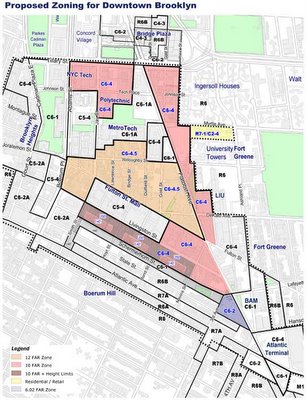 Alper cited the construction of the office tower at (Forest City Ratner’s) Atlantic Terminal mall for the Bank of New York as the “best example” of the Downtown Brooklyn strategy. (The mall is north of Atlantic Avenue, and near the southeast boundary of the Downtown Brooklyn. The Atlantic Yards project would be further southeast.) After 9/11, the Bank of New York was “almost completely knocked off line,” he said. Given that the bank’s other option was to leave the city (presumably for Jersey City and a new tax jurisdiction), “We put together an incentive package to build a new building at Atlantic Terminal.”
Alper cited the construction of the office tower at (Forest City Ratner’s) Atlantic Terminal mall for the Bank of New York as the “best example” of the Downtown Brooklyn strategy. (The mall is north of Atlantic Avenue, and near the southeast boundary of the Downtown Brooklyn. The Atlantic Yards project would be further southeast.) After 9/11, the Bank of New York was “almost completely knocked off line,” he said. Given that the bank’s other option was to leave the city (presumably for Jersey City and a new tax jurisdiction), “We put together an incentive package to build a new building at Atlantic Terminal.”
In this case, thanks to $90.8 million in Liberty Bonds, the market was given a push. (Voith in his paper criticized "the prevalent pay to play culture of ad hoc incentives;" while that may not apply to the special case of a business that almost closed in Lower Manhattan, Forest City Ratner has relied on ad hoc incentives for its other developments.)
Brooklyn’s competition for back office space is Jersey City, which buttresses a point made by panelist Mitchell Moss, a professor of urban policy and planning at New York University. “There’s a view that cities are competing with suburbs. I think cities are competing with other cities. Providence has revived because of the costs in Boston.”
Economic boost?
So, is housing downtown a boost? “Some people are concerned that you have too much residential,” Voith said. In Philadelphia, at least, increasing residential conversion has not depleted commercial space. (Neither has it done so in Miami, where residential growth is adjacent to the location of business space, but in Downtown Brooklyn and at the Atlantic Yards site, there have been tradeoffs of commercial space for residential space.) Moreover, he observed, the fiscal impact of residential development is “probably beneficial,” as Philadelphia relies on a wage tax—and many of the people paying wage taxes don’t have kids to increase school costs.
Then again, one respondent suggested, if retirees move in, they won’t be paying wage taxes. Nobody mentioned residential development as a possible spur to increased state income taxes, as in the Atlantic Yards plan, even though Pennsylvania has an income tax.
Clearly, commercial development was seen as a bigger bang. “Downtown is the local engine for redistribution,” observed Levy. “For every million square feet of office space, we can put 372 police officers on the street.” Notice that he didn’t tout market-rate residential space.
In New York, commented Alper, “You’re better off having commercial than residential” for tax receipts, citing the role of 421-A abatements in lowering property taxes. While Alper did say that real estate transfer taxes had offered a current boost to the local economy boom, he didn't argue that adding high-end housing would provide economic development through increased income taxes. (Then again, his agency did issue such an analysis, curiously without any acknowledgement of costs.)
Carl Weisbrod, former president of the Alliance for Downtown New York and current president of the Real Estate Division for Trinity Church, offered a cautionary note. While the business community in Lower Manhattan supported a transition from a 9-to-5 business neighborhood to a 24/7 mixed-use community, “I don’t think the business community recognized the conflicts.” He cited competition for land and development sites, as well as the loss of commercial tenants priced out of the neighborhood after their aging office buildings were converted to residential space.
Public process
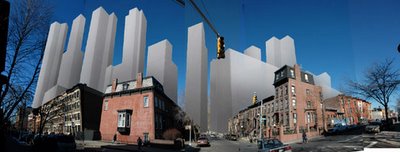 It’s already been acknowledged that there was no plan for the railyard in the Atlantic Yards footprint, nor any rezoning to stimulate construction or redevelopment along Pacific Street. And, despite Forest City Ratner’s claims, the public process has been very limited; moreover, the railyard was put out for bid 18 months after the project was announced. (Map from OnNYTurf.)
It’s already been acknowledged that there was no plan for the railyard in the Atlantic Yards footprint, nor any rezoning to stimulate construction or redevelopment along Pacific Street. And, despite Forest City Ratner’s claims, the public process has been very limited; moreover, the railyard was put out for bid 18 months after the project was announced. (Map from OnNYTurf.)
Planner and architect Barbara Faga, chair of the consultancy EDAW, described five steps for building a new downtown: establish vision, build support, determine funding, early design, implementation. “Every step of this has to have a public process involved,” she said. Such a full public process has been absent in Brooklyn.
George Hawkins, executive director, New Jersey Future, pointed out that an organized citizens’ group can often stop or slow a project often not because of its content, but because of a flawed process. “I want to emphasize the importance of public participation,” he said.
In her paper, planning professor Birch observed, "The tradition of employing neutral, urban advisors drawn from academia or private practice in plotting the course of downtowns is an important and longstanding phenomenon."
Regarding Atlantic Yards, the possibility of a lawsuit over either the ESDC’s environmental review process, or the taking of private property via eminent domain, could slow or stop the process.
Architect Jonathan Cohn, in his Brooklyn Views blog, recently commented on the distinction between the public hearing held last October by the Empire State Development Corporation and a true ventilation of the issues raised by the project: Again, the discussion was supposed to be only about the scope of a study, which is quite different from a discussion about the project itself. A real discussion about the project would address the process, the financing, the schedule, and the idea of what this project means for Brooklyn.
Planning and Jane Jacobs
Speaking before Jacobs's passing, the NYCEDC’s Alper also stressed the importance of planning in the reconstruction of Lower Manhattan after 9/11. “We had an obligation to rebuild,” he said. “We had an opportunity to rebuild the right way.”
 Lower Manhattan had been in decline, losing jobs, and the underground mall at the World Trade Center, though successful, hampered street-level retail. “Of course the huge footprint, the superblock, divided Lower Manhattan and hurt the streetscape,” he added. Note that the Bloomberg administration supports a superblock in the Atlantic Yards project, via the taking of Pacific Street on the eastern half of the footprint.
Lower Manhattan had been in decline, losing jobs, and the underground mall at the World Trade Center, though successful, hampered street-level retail. “Of course the huge footprint, the superblock, divided Lower Manhattan and hurt the streetscape,” he added. Note that the Bloomberg administration supports a superblock in the Atlantic Yards project, via the taking of Pacific Street on the eastern half of the footprint.
Alper pointed out that Lower Manhattan had not seen investments in transportation for 70 years, and lacked open space, schools, and other amenities. “It was essentially just office space. The streets rolled up at six every night,” he said, citing Jacobs’s 1961 observation, in The Death and Life of Great American Cities “that few downtowns had reached the degree of imbalance as in Lower Manhattan. We couldn’t agree more.”
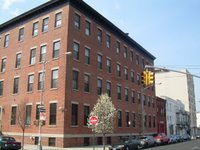 Jacobs also talked about adaptive reuse of building--and so did Birch at the conference. Notably, four former commercial or industrial buildings in Prospect Heights have recently been converted to residential use, a hallmark of the creation of new downtowns. While one of those buildings, Newswalk, has been sliced out of the plan, the other three buildings--conversions that maintain the street fabric, like the former Spalding factory at 24 Sixth Avenue (right)--would be razed to build at a density that exceeds current zoning.
Jacobs also talked about adaptive reuse of building--and so did Birch at the conference. Notably, four former commercial or industrial buildings in Prospect Heights have recently been converted to residential use, a hallmark of the creation of new downtowns. While one of those buildings, Newswalk, has been sliced out of the plan, the other three buildings--conversions that maintain the street fabric, like the former Spalding factory at 24 Sixth Avenue (right)--would be razed to build at a density that exceeds current zoning.
Not targeted at one developer
Alper said of Lower Manhattan, “We created a comprehensive plan that encourages multiple uses—the core of the mayor’s vision plan was a mixed-use, balanced community.” He cited significant investments made by the city and state, including open space such as a new East River Esplanade, transportation (a new PATH station and Fulton Street transit hub), and tax breaks to stimulate development.
The efforts contrast markedly to Alper’s testimony at the 5/4/04 City Council Economic Development Committee hearing, where he was asked: Are we doing this now because this has been brought to us, or are we doing this because we proactively looked and said, we think this is good for Downtown Brooklyn, and we think this is good for New York City? And depending on your answer, the second part of it is, how do you know it is a good deal, unless we know that there is somebody else out there?
Alper responded that the city was marketing itself, but added:
This particular project came to us…. The developer came to us with what we though was actually a very clever plan. It is not only bringing a sports team back to Brooklyn, but to do it in a way that provided dramatic economic development catalyst in terms of housing, retail, commercial jobs, construction jobs, permanent jobs. So, they came to us, we did not come to them. And it is not really up to us then to go out and find to try to a better deal. I think that would discourage developers from coming to us, if every time they came to us we went out and tried to shop their idea to somebody else. So we are actively shopping, but not for another sports arena franchise for Brooklyn.”
This suggests that the key to Forest City Ratner's strategy was leveraging a scarce commodity—a sports team and arena—for favorable terms regarding a less scarce commodity, the right to develop office and residential space. The developer gained a further advantage--not just development rights, but at a scale that overrides city zoning. At City Council, Alper turned it into a question just about sports.
How it should work
Alper described how the city is stimulating development in dozens of projects, ncluding 19 outside Manhattan. The city has made transportation improvements, streetscape improvements, rezoned city land, and put out RFPs for city properties. All of these were absent in the Atlantic Yards process or—rather—infrastructure improvements were promised to a favored developer.
David Thornburgh, former executive director of the Pennsylvania Economy League, pointed to two “x factors” regarding resurgent downtowns. First, he cited the importance of competitive transaction costs, such as permitting and site acquisition. Further, he said, that the political culture must be clean, not corrupt or “pay-to-play,” in which palms are greased. “Those cities with straight line cultures will do better in the long run.”
While there’s no evidence that economic development is pay-to-play, that certainly describes Brooklyn’s political culture regarding judgeships, and it should be noted that the Atlantic Yards Community Benefits Agreement involves the vice chairwoman of the Brooklyn Democratic Party. Moreover, the use of lobbying and strategic charitable donations, plus the support for “community” groups in the CBA process, suggests a culture that is hardly “straight line.”
What are the boundaries?
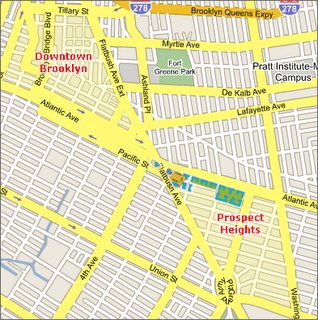 How draw the boundaries of a downtown? “There is no accepted definition,” Birch stated. “You have to ask the people for their opinions. Boundaries are moving outward.”
How draw the boundaries of a downtown? “There is no accepted definition,” Birch stated. “You have to ask the people for their opinions. Boundaries are moving outward.”
So, would the Atlantic Yards project constitute a new downtown? The proposed footprint—except for two relatively small parcels at the western edge—was not considered as part of the Downtown Brooklyn rezoning. The area of Prospect Heights proposed for the footprint has been a mix of industrial, commercial, and residential spaces.
Interestingly, in Brooklyn, major cultural institutions are not downtown but rather on the edge (the Brooklyn Academy of Music and the proposed Visual and Performing Arts Library) or a mile or so away in the Grand Army Plaza area (the Central Library, Prospect Park, and the Brooklyn Museum). That suggests that the construction of housing at the Atlantic Yards footprint might be even more valuable.
Affordable housing
One lurking issue in downtown redevelopment concerns the provision of affordable housing. Commented Vishaan Chakrabarti, VP, The Related Companies, which does much business in New York City: “I believe affordable housing should be mandated. I don’t think it will hurt the development. We will not fulfill the economic needs of the city without a diverse population.”
Chakrabarti, however, was not about to take aim at the city's much-criticized 421-A subsidy for market-rate housing. Rather, he suggested “the silver bullet” was that New York gives the federal government $18 billion more than it gets back. A legitimate point, but not at the exclusion of reforming subsidies that support luxury development.
Can affordable housing be mandated? Voith observed, “If you create an environment that delivers amenities people value, the prices rise well beyond construction costs.” (Indeed, that’s what’s happened in Brooklyn.) “You can mandate affordable housing—the effect is on the land price, not the developer.”
That suggests we should see the pro forma that lays out Forest City Ratner’s financial projections. And it also means that, had the city and MTA decided on an open public process to build housing, and affordable housing, over the Vanderbilt Yard, the issue could have been hashed out publicly rather than negotiated between FCR and ACORN.
Interestingly, Philadelphia has more flexibility than New York, given the numerous neighborhoods that have yet to revive. “In Philadelphia, we don’t have to worry about affordable housing,” Levy said, “because they’re moving the edge out, and we have a good transit system."
 While the mostly-residential Atlantic Yards has been promoted by the developer as an economic development engine (because of the dubious theory of increased income tax revenues), the development of residential over commercial space was hardly heralded in the same manner. (Graphic of earlier version of plan from 7/5/05 New York Times, with addenda by NoLandGrab.org.)
While the mostly-residential Atlantic Yards has been promoted by the developer as an economic development engine (because of the dubious theory of increased income tax revenues), the development of residential over commercial space was hardly heralded in the same manner. (Graphic of earlier version of plan from 7/5/05 New York Times, with addenda by NoLandGrab.org.)While there was no planning for the Atlantic Yards site and there has been little public process, panelists cited the value of neutral planners and the importance of public participation.
 While Atlantic Yards would be a single-source project announced as a fait accompli, panelists stressed the importance of a level playing field and an open competition for sites.
While Atlantic Yards would be a single-source project announced as a fait accompli, panelists stressed the importance of a level playing field and an open competition for sites.While Atlantic Yards would close streets to create a superblock and otherwise violate some precepts advocated by urbanist Jane Jacobs (RIP), a panelist from the Bloomberg administration presented Jacobs’s insights as enduringly valuable. (Indeed, there was no example in the panels of a major rezoning--or in the case of Atlantic Yards, a state override of city zoning--to stimulate a much more dense development.)
Live. Work? Play.
First, Downtown Brooklyn—and Forest City Ratner's proposed extension via the Atlantic Yards project—may not qualify as a “new downtown,” because its development, as of now, is skewed toward residential space. Moreover, part of the proposed footprint is a long-neglected segment of an "old" redevelopment effort, the 1960s-era Atlantic Terminal Urban Renewal Area (ATURA).
 A “new downtown,” according to a definition presented by Eugenie Birch, of the Penn Institute for Urban Research of the University of Pennsylvania, is a central business district and its surrounds that has experienced reinvention as a well-populated, mixed-use center suitable for living, working, and playing. It has low vacancy rates and high usage of its infrastructure and amenities. Its tax revenues soar and its household growth rates surpass its city’s. It is an icon of urban resilience and renaissance. Its reach extends beyond the traditional central business district into nearby neighborhoods… [It] has new residential, entertainment, cultural, and recreational activities and has refashioned its retail and office employment.
A “new downtown,” according to a definition presented by Eugenie Birch, of the Penn Institute for Urban Research of the University of Pennsylvania, is a central business district and its surrounds that has experienced reinvention as a well-populated, mixed-use center suitable for living, working, and playing. It has low vacancy rates and high usage of its infrastructure and amenities. Its tax revenues soar and its household growth rates surpass its city’s. It is an icon of urban resilience and renaissance. Its reach extends beyond the traditional central business district into nearby neighborhoods… [It] has new residential, entertainment, cultural, and recreational activities and has refashioned its retail and office employment. This would apply only partly to Brooklyn. Notably, even though Downtown Brooklyn has been rezoned to accommodate new office construction, developers have been building residential towers rather than office space. In planning to turn Prospect Heights into Downtown Brooklyn with the Atlantic Yards project, Forest City Ratner originally promoted a mix of residential, office, and recreational uses. Though the “Live. Work. Play.” slogan was promoted heavily by FCR in the early stages of public discussion, the new AtlanticYards.com web site drops that formulation, likely because FCR recognizes that it’s hard to promote “Work” when the number of promised office jobs has been slashed from 10,000 to 2500. (Graphic is of new projects at Gold Street.)
This would apply only partly to Brooklyn. Notably, even though Downtown Brooklyn has been rezoned to accommodate new office construction, developers have been building residential towers rather than office space. In planning to turn Prospect Heights into Downtown Brooklyn with the Atlantic Yards project, Forest City Ratner originally promoted a mix of residential, office, and recreational uses. Though the “Live. Work. Play.” slogan was promoted heavily by FCR in the early stages of public discussion, the new AtlanticYards.com web site drops that formulation, likely because FCR recognizes that it’s hard to promote “Work” when the number of promised office jobs has been slashed from 10,000 to 2500. (Graphic is of new projects at Gold Street.)Panelist Paul Levy, president and CEO, Philadelphia Center City District, noted that 60 percent of downtown Philadelphia residents work downtown, and 37 percent walk to work. “We are reclaiming people who live in the suburbs,” he said, adding that new residents also cited the ability to walk to arts facilities and other amenities. In Brooklyn, most of those moving downtown or to the Atlantic Yards project likely would take the subway to Manhattan for work.
Elizabeth Strom, a geography professor at the University of South Florida, observed that, for generations, urban density was determined by constraints caused by transportation, communication, technology, and safety. After the decline of downtowns, and the departure of former mainstays like banks, insurance companies, and department stores, the new downtown was coaxed by public and philanthropic dollars, not the market.
Now downtown development corporations are dominated by real estate concerns, along with can’t-leave-the-city institutions in health care and higher education. The “new downtown,” Strom observed, is about culture, entertainment, restaurants, and residences. “It’s just not economically important the way it used to be.”
Why the new Downtown?
Economist Richard Voith, VP of Philadelphia-based Econsult Corporation, and a panel of respondents offered several reasons for the decline of downtown, and its revival. (Voith's paper is here.) Suburbanization and the automobile fueled the post-war decline of central cities. Burdened by higher social and service costs, faced with a lack of federal investment, cities lost power regionally and nationally. Cities became notorious for crime and underperforming schools. Beyond that, telecommunication advances were thought to have eliminated the need for face to face contacts.
However, downtowns bounced back in the 1980s. Post-college youth always move to cities and, because they got married and had kids later, were more likely to stay. Baby boomers downsized from the suburbs and moved back for urban amenities. Costs in the suburbs increased, and many recognized the implicit costs of commuting times. Cities made changes, such as offering tax incentives and creating Business Improvement Districts (BIDs) to foster residential construction and amenities. New mayors focused on fighting crime and improving schools.
Observed Levy: “I don’t think we’re restoring the CBD [Central Business District] of 1910 but the downtown of 1850 that was a live-work environment, that has never ceased to exist in Europe.” The residential use was squeezed out in the 1890s, as cities boomed, but the transit network makes urban life attractive.
Levy noted that deliberate federal policies undermined cities. “From 1934 to 1968, every American city was redlined by the FHA [Federal Housing Administration],” he said, adding that gas price subsidies and highway spending also fostered suburbanization. “Maybe we can consider the investments in downtowns as reparations payments.”
Jobs crucial
 “We have to remember that the downtown holds jobs,” Birch said. “Downtown jobs are extremely important for supporting the neighborhoods.” And the questions was also addressed by Andrew Alper, president of the New York City Economic Development Corporation (right), the keynote speaker at lunch.
“We have to remember that the downtown holds jobs,” Birch said. “Downtown jobs are extremely important for supporting the neighborhoods.” And the questions was also addressed by Andrew Alper, president of the New York City Economic Development Corporation (right), the keynote speaker at lunch.Is there too much residential in a business district, Alper asked rhetorically, as he discussed the transformation of Lower Manhattan. “My response, based on my [University of] Chicago free market training, is we should let the market work,” he said, though he allowed that “sometimes the market needs a push.”
Asked about the emphasis in Downtown Brooklyn on residential construction, Alper said that the area remains “natural back office space” for Manhattan companies that need to diversify their locations. “Until recently, there’s been excess space in Lower Manhattan,” he said, perhaps overselling the amount of space that’s been filled at the World Trade Center. “I think you’ll see that change.” Perhaps that’s why Forest City Ratner is retaining an alternative plan that would restore most of the slashed commercial space.
 Alper cited the construction of the office tower at (Forest City Ratner’s) Atlantic Terminal mall for the Bank of New York as the “best example” of the Downtown Brooklyn strategy. (The mall is north of Atlantic Avenue, and near the southeast boundary of the Downtown Brooklyn. The Atlantic Yards project would be further southeast.) After 9/11, the Bank of New York was “almost completely knocked off line,” he said. Given that the bank’s other option was to leave the city (presumably for Jersey City and a new tax jurisdiction), “We put together an incentive package to build a new building at Atlantic Terminal.”
Alper cited the construction of the office tower at (Forest City Ratner’s) Atlantic Terminal mall for the Bank of New York as the “best example” of the Downtown Brooklyn strategy. (The mall is north of Atlantic Avenue, and near the southeast boundary of the Downtown Brooklyn. The Atlantic Yards project would be further southeast.) After 9/11, the Bank of New York was “almost completely knocked off line,” he said. Given that the bank’s other option was to leave the city (presumably for Jersey City and a new tax jurisdiction), “We put together an incentive package to build a new building at Atlantic Terminal.” In this case, thanks to $90.8 million in Liberty Bonds, the market was given a push. (Voith in his paper criticized "the prevalent pay to play culture of ad hoc incentives;" while that may not apply to the special case of a business that almost closed in Lower Manhattan, Forest City Ratner has relied on ad hoc incentives for its other developments.)
Brooklyn’s competition for back office space is Jersey City, which buttresses a point made by panelist Mitchell Moss, a professor of urban policy and planning at New York University. “There’s a view that cities are competing with suburbs. I think cities are competing with other cities. Providence has revived because of the costs in Boston.”
Economic boost?
So, is housing downtown a boost? “Some people are concerned that you have too much residential,” Voith said. In Philadelphia, at least, increasing residential conversion has not depleted commercial space. (Neither has it done so in Miami, where residential growth is adjacent to the location of business space, but in Downtown Brooklyn and at the Atlantic Yards site, there have been tradeoffs of commercial space for residential space.) Moreover, he observed, the fiscal impact of residential development is “probably beneficial,” as Philadelphia relies on a wage tax—and many of the people paying wage taxes don’t have kids to increase school costs.
Then again, one respondent suggested, if retirees move in, they won’t be paying wage taxes. Nobody mentioned residential development as a possible spur to increased state income taxes, as in the Atlantic Yards plan, even though Pennsylvania has an income tax.
Clearly, commercial development was seen as a bigger bang. “Downtown is the local engine for redistribution,” observed Levy. “For every million square feet of office space, we can put 372 police officers on the street.” Notice that he didn’t tout market-rate residential space.
In New York, commented Alper, “You’re better off having commercial than residential” for tax receipts, citing the role of 421-A abatements in lowering property taxes. While Alper did say that real estate transfer taxes had offered a current boost to the local economy boom, he didn't argue that adding high-end housing would provide economic development through increased income taxes. (Then again, his agency did issue such an analysis, curiously without any acknowledgement of costs.)
Carl Weisbrod, former president of the Alliance for Downtown New York and current president of the Real Estate Division for Trinity Church, offered a cautionary note. While the business community in Lower Manhattan supported a transition from a 9-to-5 business neighborhood to a 24/7 mixed-use community, “I don’t think the business community recognized the conflicts.” He cited competition for land and development sites, as well as the loss of commercial tenants priced out of the neighborhood after their aging office buildings were converted to residential space.
Public process
 It’s already been acknowledged that there was no plan for the railyard in the Atlantic Yards footprint, nor any rezoning to stimulate construction or redevelopment along Pacific Street. And, despite Forest City Ratner’s claims, the public process has been very limited; moreover, the railyard was put out for bid 18 months after the project was announced. (Map from OnNYTurf.)
It’s already been acknowledged that there was no plan for the railyard in the Atlantic Yards footprint, nor any rezoning to stimulate construction or redevelopment along Pacific Street. And, despite Forest City Ratner’s claims, the public process has been very limited; moreover, the railyard was put out for bid 18 months after the project was announced. (Map from OnNYTurf.)Planner and architect Barbara Faga, chair of the consultancy EDAW, described five steps for building a new downtown: establish vision, build support, determine funding, early design, implementation. “Every step of this has to have a public process involved,” she said. Such a full public process has been absent in Brooklyn.
George Hawkins, executive director, New Jersey Future, pointed out that an organized citizens’ group can often stop or slow a project often not because of its content, but because of a flawed process. “I want to emphasize the importance of public participation,” he said.
In her paper, planning professor Birch observed, "The tradition of employing neutral, urban advisors drawn from academia or private practice in plotting the course of downtowns is an important and longstanding phenomenon."
Regarding Atlantic Yards, the possibility of a lawsuit over either the ESDC’s environmental review process, or the taking of private property via eminent domain, could slow or stop the process.
Architect Jonathan Cohn, in his Brooklyn Views blog, recently commented on the distinction between the public hearing held last October by the Empire State Development Corporation and a true ventilation of the issues raised by the project: Again, the discussion was supposed to be only about the scope of a study, which is quite different from a discussion about the project itself. A real discussion about the project would address the process, the financing, the schedule, and the idea of what this project means for Brooklyn.
Planning and Jane Jacobs
Speaking before Jacobs's passing, the NYCEDC’s Alper also stressed the importance of planning in the reconstruction of Lower Manhattan after 9/11. “We had an obligation to rebuild,” he said. “We had an opportunity to rebuild the right way.”
 Lower Manhattan had been in decline, losing jobs, and the underground mall at the World Trade Center, though successful, hampered street-level retail. “Of course the huge footprint, the superblock, divided Lower Manhattan and hurt the streetscape,” he added. Note that the Bloomberg administration supports a superblock in the Atlantic Yards project, via the taking of Pacific Street on the eastern half of the footprint.
Lower Manhattan had been in decline, losing jobs, and the underground mall at the World Trade Center, though successful, hampered street-level retail. “Of course the huge footprint, the superblock, divided Lower Manhattan and hurt the streetscape,” he added. Note that the Bloomberg administration supports a superblock in the Atlantic Yards project, via the taking of Pacific Street on the eastern half of the footprint. Alper pointed out that Lower Manhattan had not seen investments in transportation for 70 years, and lacked open space, schools, and other amenities. “It was essentially just office space. The streets rolled up at six every night,” he said, citing Jacobs’s 1961 observation, in The Death and Life of Great American Cities “that few downtowns had reached the degree of imbalance as in Lower Manhattan. We couldn’t agree more.”
 Jacobs also talked about adaptive reuse of building--and so did Birch at the conference. Notably, four former commercial or industrial buildings in Prospect Heights have recently been converted to residential use, a hallmark of the creation of new downtowns. While one of those buildings, Newswalk, has been sliced out of the plan, the other three buildings--conversions that maintain the street fabric, like the former Spalding factory at 24 Sixth Avenue (right)--would be razed to build at a density that exceeds current zoning.
Jacobs also talked about adaptive reuse of building--and so did Birch at the conference. Notably, four former commercial or industrial buildings in Prospect Heights have recently been converted to residential use, a hallmark of the creation of new downtowns. While one of those buildings, Newswalk, has been sliced out of the plan, the other three buildings--conversions that maintain the street fabric, like the former Spalding factory at 24 Sixth Avenue (right)--would be razed to build at a density that exceeds current zoning. Not targeted at one developer
Alper said of Lower Manhattan, “We created a comprehensive plan that encourages multiple uses—the core of the mayor’s vision plan was a mixed-use, balanced community.” He cited significant investments made by the city and state, including open space such as a new East River Esplanade, transportation (a new PATH station and Fulton Street transit hub), and tax breaks to stimulate development.
The efforts contrast markedly to Alper’s testimony at the 5/4/04 City Council Economic Development Committee hearing, where he was asked: Are we doing this now because this has been brought to us, or are we doing this because we proactively looked and said, we think this is good for Downtown Brooklyn, and we think this is good for New York City? And depending on your answer, the second part of it is, how do you know it is a good deal, unless we know that there is somebody else out there?
Alper responded that the city was marketing itself, but added:
This particular project came to us…. The developer came to us with what we though was actually a very clever plan. It is not only bringing a sports team back to Brooklyn, but to do it in a way that provided dramatic economic development catalyst in terms of housing, retail, commercial jobs, construction jobs, permanent jobs. So, they came to us, we did not come to them. And it is not really up to us then to go out and find to try to a better deal. I think that would discourage developers from coming to us, if every time they came to us we went out and tried to shop their idea to somebody else. So we are actively shopping, but not for another sports arena franchise for Brooklyn.”
This suggests that the key to Forest City Ratner's strategy was leveraging a scarce commodity—a sports team and arena—for favorable terms regarding a less scarce commodity, the right to develop office and residential space. The developer gained a further advantage--not just development rights, but at a scale that overrides city zoning. At City Council, Alper turned it into a question just about sports.
How it should work
Alper described how the city is stimulating development in dozens of projects, ncluding 19 outside Manhattan. The city has made transportation improvements, streetscape improvements, rezoned city land, and put out RFPs for city properties. All of these were absent in the Atlantic Yards process or—rather—infrastructure improvements were promised to a favored developer.
David Thornburgh, former executive director of the Pennsylvania Economy League, pointed to two “x factors” regarding resurgent downtowns. First, he cited the importance of competitive transaction costs, such as permitting and site acquisition. Further, he said, that the political culture must be clean, not corrupt or “pay-to-play,” in which palms are greased. “Those cities with straight line cultures will do better in the long run.”
While there’s no evidence that economic development is pay-to-play, that certainly describes Brooklyn’s political culture regarding judgeships, and it should be noted that the Atlantic Yards Community Benefits Agreement involves the vice chairwoman of the Brooklyn Democratic Party. Moreover, the use of lobbying and strategic charitable donations, plus the support for “community” groups in the CBA process, suggests a culture that is hardly “straight line.”
What are the boundaries?
 How draw the boundaries of a downtown? “There is no accepted definition,” Birch stated. “You have to ask the people for their opinions. Boundaries are moving outward.”
How draw the boundaries of a downtown? “There is no accepted definition,” Birch stated. “You have to ask the people for their opinions. Boundaries are moving outward.” So, would the Atlantic Yards project constitute a new downtown? The proposed footprint—except for two relatively small parcels at the western edge—was not considered as part of the Downtown Brooklyn rezoning. The area of Prospect Heights proposed for the footprint has been a mix of industrial, commercial, and residential spaces.
Interestingly, in Brooklyn, major cultural institutions are not downtown but rather on the edge (the Brooklyn Academy of Music and the proposed Visual and Performing Arts Library) or a mile or so away in the Grand Army Plaza area (the Central Library, Prospect Park, and the Brooklyn Museum). That suggests that the construction of housing at the Atlantic Yards footprint might be even more valuable.
Affordable housing
One lurking issue in downtown redevelopment concerns the provision of affordable housing. Commented Vishaan Chakrabarti, VP, The Related Companies, which does much business in New York City: “I believe affordable housing should be mandated. I don’t think it will hurt the development. We will not fulfill the economic needs of the city without a diverse population.”
Chakrabarti, however, was not about to take aim at the city's much-criticized 421-A subsidy for market-rate housing. Rather, he suggested “the silver bullet” was that New York gives the federal government $18 billion more than it gets back. A legitimate point, but not at the exclusion of reforming subsidies that support luxury development.
Can affordable housing be mandated? Voith observed, “If you create an environment that delivers amenities people value, the prices rise well beyond construction costs.” (Indeed, that’s what’s happened in Brooklyn.) “You can mandate affordable housing—the effect is on the land price, not the developer.”
That suggests we should see the pro forma that lays out Forest City Ratner’s financial projections. And it also means that, had the city and MTA decided on an open public process to build housing, and affordable housing, over the Vanderbilt Yard, the issue could have been hashed out publicly rather than negotiated between FCR and ACORN.
Interestingly, Philadelphia has more flexibility than New York, given the numerous neighborhoods that have yet to revive. “In Philadelphia, we don’t have to worry about affordable housing,” Levy said, “because they’re moving the edge out, and we have a good transit system."
Comments
Post a Comment